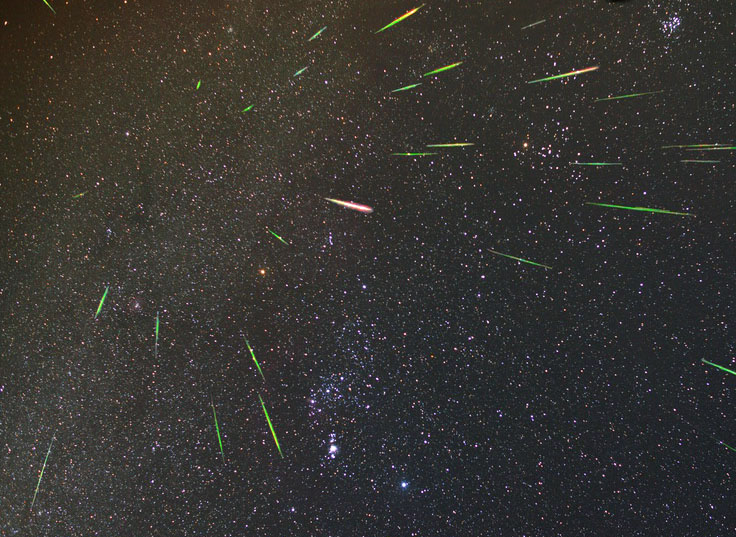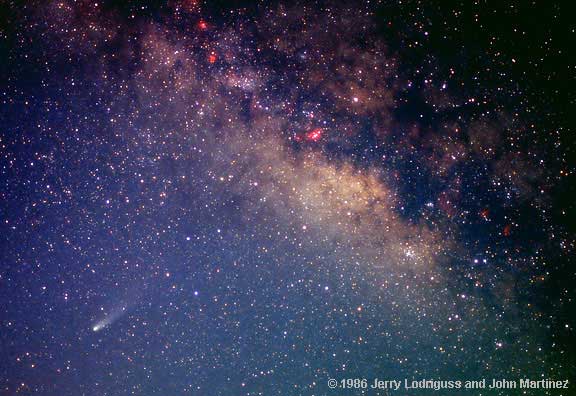Every 75-76 years, a bright comet returns to the inner regions of the Solar System, named after the outstanding English astronomer Edmond Halley. It was he who, at the beginning of the XVIII century, proved its periodicity and predicted the next appearance. Its return in 1986 was not entirely successful for observers in our latitudes. Now it is approaching its aphelion — the most distant point of the orbit from the Sun, which will take place on December 9, 2023. We won’t be able to see this “tailed star” with the naked eye for a while, but, nevertheless, every year astronomers receive reminders about it. One of them is the Orionid meteor shower, the maximum of which falls on October 21-22.
The radiant of the Orionid stream — an imaginary point on the celestial sphere from which its meteors “fly away” — is located in the constellation Orion, not far from its “border” with Gemini, and the nearest bright star to it is Alhena (γ Geminorum). In the second half of October, it rises at about 10 pm, and culminates before dawn. At the peak of activity, more than 20 meteors per hour are regularly observed. There are many bright ones among them, and they all stand out for their high speed. The fact is that Halley’s comet orbits the Sun in the opposite direction to the rotation of the major planets. Therefore, dust particles ejected from its core collide with the Earth almost “on opposite courses”, due to which they have a high relative speed — almost 67 km/s. Consequently, their kinetic energy per unit mass is also quite large, and almost all of it is converted into thermal energy due to collisions with atmospheric gas molecules. That’s what we see as a meteor flash.

In historical times, the Orionids never produced large meteor showers, although sometimes their activity increased unpredictably: for example, in 2006-2007, it reached a maximum of 70 meteors per hour. At first glance, this seems strange — at this time, the “parent” comet of the shower has already moved away from the Sun by a considerable distance, along with the main cloud of dust particles ejected by it. On the other hand, in the years shortly before and shortly after the comet’s perihelion passage (1984-1987), the power of the Orionids did not greatly exceed the average values. What’s the matter here?
According to calculations, Halley’s comet first entered the inner region of the Solar System more than 15 thousand years ago, and during this time it made at least two hundred orbits the Sun. During each of these orbits, its orbit was slightly different from the previous one, gradually evolving under the influence of the gravity of large planets and the reactive force of gases ejected from the cometary nucleus. Fifteen hundred years ago, it was located so that it could approach the Earth’s orbit by less than 0.03 AU (4.5 million km). On April 10, 837, the closest approach of the comet to the Earth for all the time of its known observations took place. The clouds of dust thrown out by it at that epoch formed the meteor swarm of the η Aquarii — one of the three most powerful showers of our sky. Due to further gravitational disturbances and the “shift” of the calendar, its maximum now falls on May 5.

Orionids have been regularly observed since their discovery in 1839. Astronomers were able to “tie” them to Halley’s comet later — in the mid-1860s, during the rapid development of meteor astronomy. This shower is formed by dust particles ejected by the comet much earlier — several thousand years ago, when its orbit came closest to the earth near the part of the last that our planet passes in October. Each of its flights left its own “meteor plume”. Scientists can find out where the clumps of this meteoric substance are located only by analyzing information about changes in the activity of the Orionids. Therefore, their observations have a certain value in studying the evolution of the Solar System, and in the space age they also allow us to assess the current level of danger to satellites and manned spacecraft in near-Earth orbits. Such observations do not require serious tools and can be made by astronomy enthusiasts.
Follow us on Twitter to get the most interesting space news in time
https://twitter.com/ust_magazine

